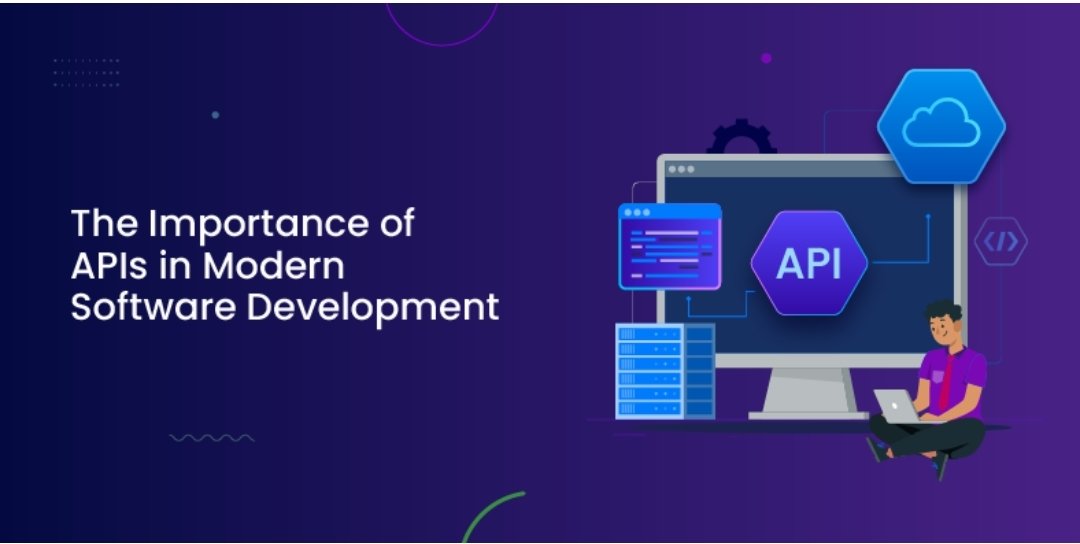
APIs for Modern Software Development
APIs serve as bridge that connects various software systems, enabling seamless communication between them. They create a more connected and integrated digital landscape. APIs define how data and requests are exchanged. They allow one application to securely access another’s functionalities.
Acting as intermediaries, APIs enable developers to connect systems, access third-party services, and integrate applications without altering the underlying code. They also promote efficiency, providing developers with pre-built functionalities and reducing redundant coding.
This blog will explain how APIs software development drive interoperability, scalability, and innovation in software development, offering businesses opportunities to create integrated, adaptable solutions that meet evolving demands.
What is an API?
An API (Application Programming Interface) is a set of protocols and tools that allow different software applications to communicate and exchange data. It acts as a bridge, enabling one application to access predefined functions and data from another without exposing internal code details.
Types of APIs
API types vary based on their use cases:
- REST (Representational State Transfer): REST APIs use HTTP protocols, providing a flexible, lightweight, and stateless approach to data exchange. They are ideal for quick, scalable applications like social media or e-commerce sites.
- SOAP (Simple Object Access Protocol): SOAP APIs are more rigid but offer high security and reliability through XML-based messaging. It is suitable for critical applications like financial and healthcare systems.
- GraphQL: This query language enables clients to request specific data, optimizing network use and speed. It is ideal for apps with complex data needs, such as social networks and data dashboards.
- gRPC (gRemote Procedure Call): A high-performance RPC framework using HTTP/2 that is efficient for low-latency needs in microservices or IoT.
How do APIs work?
APIs facilitate communication between applications through defined requests, responses, and protocols:
- Requests and Responses: The client (requester) requests the API with details like the endpoint, parameters, and the HTTP method (action). The server processes this and returns a response, often in JSON or XML.
- HTTP Protocol: APIs commonly use HTTP to define how requests and responses are formatted and handled.
- Common HTTP Methods:
- GET: Retrieves data (e.g., fetching a product list).
- POST: Submits data to create a record (e.g., adding user details).
- PUT: Updates data (e.g., modifying a user profile).
- DELETE: Removes data (e.g., deleting a product from inventory).
APIs as Enablers of Interoperability
The primary role of APIs in the software ecosystem is to enable interoperability. Simply put, it allows diverse systems, platforms, and applications to interact seamlessly. Through structured communication methods, APIs connect different software systems, enabling data exchange and operations across platforms.
Connecting Disparate Systems
One of APIs’ most crucial roles in software development is bridging disparate systems. These systems are meant to serve different roles and are often built with different technologies, making direct communication difficult.
APIs provide a standardized method for data exchange and interaction across different technologies, such as CRM and ERP software. This integration, a core feature of API-driven development, allows systems like sales databases and order management tools to interact seamlessly, offering users a unified view of data in real time.
Cross-Platform Integration
APIs are crucial for cross-platform integration, allowing applications to interact across web, mobile, desktop, and IoT platforms. They standardize data exchange formats like JSON and XML, enabling consistent device functionality.
Similarly, APIs let IoT devices connect with cloud services for data storage and updates. This interoperability enables businesses to reach users on their preferred devices, enhancing user engagement and providing a seamless experience across multiple touchpoints.
Standardization and Compatibility
APIs provide standardized methods for application interaction across different programming languages, frameworks, and architectures, using protocols like HTTP and data formats like JSON or XML. This standardization ensures compatibility between new and legacy systems, enabling seamless interaction even with older technology.
This approach supports legacy modernization, allowing businesses to upgrade incrementally. This reduces replacement costs and builds a flexible, future-proof infrastructure where diverse systems work together effectively.
The Role of APIs in Enhancing Scalability
APIs enhance scalability in modern applications by enabling modular architectures. They integrate cloud services and support performance optimization. This scalability ensures applications remain flexible, reliable, and responsive to users’ and businesses’ evolving needs in a fast-paced digital landscape.
Modular Development through Microservices
APIs are key to modular development in microservices architectures, allowing large applications to be divided into independent, focused services—like user authentication or payment processing—that communicate through APIs.
This approach enables teams to update and scale services individually, improving efficiency and flexibility. API-driven development of microservices architectures thus supports scalable, adaptable, and responsive applications that easily meet evolving business needs.
Cloud Scalability and API Integration
Cloud-based APIs enable applications to utilize the scalability, storage, and processing power of cloud infrastructure. Platforms like AWS, Azure, and Google Cloud provide APIs for dynamic access to resources like storage and computing power. APIs support cloud-native scalability through serverless functions, containerization, and auto-scaling.
Serverless functions allocate resources only when triggered, reducing idle costs. Containerization ensures consistent operation across environments, while APIs enable container communication. Auto-scaling uses APIs to adjust resources based on demand, ensuring stable performance during traffic spikes.
Load Balancing and Performance Optimization
APIs enhance application performance through load balancing and caching. Load balancing distributes incoming requests across multiple servers, preventing single-server overloads and ensuring fast response times. APIs facilitate communication between load balancers and servers to direct requests to the most available resources, maintaining stability during peak usage.
For performance optimization, APIs enable caching, reducing server load by storing frequently accessed data, such as product details, in an e-commerce app. Cached data minimizes repeated database queries, speeds up responses, and improves user experience.
APIs as Catalysts for Innovation and Speed in Development
APIs drive innovation and speed development by providing ready-made solutions that reduce the need for building from scratch. They enable rapid prototyping, quick feature launches, and faster time to market, allowing developers to focus on the unique aspects of their products.
Accelerating Development with Pre-Built Solutions
APIs offer pre-built functionalities, like payment processing, geolocation, and user authentication, that developers can integrate directly into applications. This saves time and effort, as developers avoid building these complex services from scratch. This approach allows companies to allocate resources toward core features and innovation, enhancing their overall product offerings.
To maximize the efficiency of API integration and utilize specialized functionalities, businesses often turn to professional API development services. These services help integrate complex features such as payment processing and geolocation quickly, reducing time-to-market and costs.
Facilitating Experimentation and Prototyping
APIs enable quick experimentation and prototyping by allowing developers to test new features and integrations with minimal effort. They can connect to third-party services or gather data temporarily, supporting agile development by enabling rapid iteration based on feedback. APIs also streamline building Minimum Viable Products (MVPs), as developers can use existing services for core features, reducing development time.
Encouraging Ecosystem Growth
APIs from companies like Google, Facebook, and Amazon encourage ecosystem growth by allowing external developers to build on their platforms. Through APIs, developers can integrate features like social sharing, data storage, and cloud services into their apps.
Thus, businesses can take advantage of these established infrastructure and user bases. This collaboration benefits platform owners by extending their reach and keeping users engaged with diverse applications. Developers gain tools for faster growth and revenue opportunities.
APIs and Data Access: Driving Better User Experiences
APIs are vital for enhancing data access. They enable applications to provide real-time information, personalized features, and data-driven insights. By connecting applications with data sources, APIs help businesses boost user engagement and improve decision-making.
Real-Time Data Access
APIs enable real-time data access, allowing applications to display live information to users. This functionality ensures that users receive the most current and relevant data, which is crucial in dynamic environments.
APIs create engaging user experiences that promote interaction by offering instant access to updated information. For example, financial applications use APIs to show live stock prices and market trends, while news apps provide breaking news updates.
Personalization and User-Centric Features
APIs are essential for creating personalized user experiences. APIS can access data from various sources to tailor content, recommendations, and interfaces to individual preferences. This is particularly helpful for E-commerce to improve the shopping experience.
As users increasingly expect the application to meet their needs, it boosts engagement, user satisfaction, and purchase likelihood. By understanding user behavior, businesses can actually know their customers. Thus, APIs can add value to your application, improving brand loyalty.
Data-Driven Decision Making
APIs can collect, integrate, and share data among various systems by acting as a bridge between them, opening up many possibilities. API tools can help businesses visualize trends and track performance easily by connecting to analytics platforms and business intelligence (BI) tools.
This visualization further helps businesses devise effective strategies to meet their goals. APIs also enable monitoring key performance indicators (KPIs) in real-time, which is crucial for identifying patterns and responding quickly to market changes.
APIs in Enhancing Security and Compliance
Another crucial role of APIs in software is enhancing security and ensuring compliance with regulatory standards. Software development with an API security framework helps businesses protect sensitive data and prevent unauthorized access.
Authentication and Authorization
API authentication and authorization mechanisms are essential for protecting sensitive data and ensuring only authorized users can access it. Authentication verifies user identities, while authorization determines their permitted actions. Key methods include:
- OAuth (Open Authorization): It is a widely used protocol that allows applications to access user resources without sharing passwords.
- API Keys: These are unique codes issued to developers or applications for authenticating requests.
- JWT (JSON Web Tokens): They are encoded tokens that transmit information securely between applications.
These mechanisms are vital for securing APIs, preventing unauthorized access, protecting sensitive data, and giving users confidence in the security of their information.
Data Encryption and Secure Transfer
APIs use encryption as a primary method to safeguard the data in transmission. This also ensures data privacy and protects from unauthorized access. Key methods include:
- HTTPS (Hypertext Transfer Protocol Secure): It is the extension of the standard HTTP which is enhanced with the help of SSL (Secure Sockets Layer) or TLS (Transport Layer Security) encryption.
- SSL/TLS (Secure Sockets Layer / Transport Layer Security): These protocols establish a secure connection over the network through an encrypted link between the client and the server.
Regulatory Compliance
One of the lesser talked-about benefits of APIs is they help businesses comply with regulatory requirements related to data privacy and security. This includes compliance with regulations like GDPR, HIPAA, and CCPA through:
- Controlled Data Access: APIs enable businesses to set and limit access to data based on regulatory standards. This ensures that only authorized users or applications can access sensitive information.
- Data Tracking and Auditing: APIs maintain logs of every interaction, documenting data access and usage. This allows organizations to track who accessed data and why.
- Adherence to Privacy Regulations: APIs help businesses enforce data protection measures and manage user consent as mandated by regulations like GDPR.
Future Trends and Innovations in APIs
APIs are evolving with the emerging trends and innovations to address the changing demands. Software development with APIs are now integrating newer technologies to benefit from enhanced performance, security, and intelligent functionality. Key trends include:
- AI-Powered APIs: AI and ML are expanding applications’ capabilities with intelligent features, and APIs are no different. By integrating NLP and image recognition APIs, businesses are automating tasks such as visual search, facial recognition, or product identification. This enhances functionalities and user experience.
- Event-Driven Models: Event-driven APIs are now extensively used for creating IoT systems and responsive applications that require real-time communication and data updates.
- GraphQL: GraphQL offers a significant advantage in API design. It allows retrieval of multiple resources in a single request, improving efficiency by minimizing over-fetching and under-fetching of information.
- Enhanced Security: Software development with APIs are becoming the norm. Thus, API security is also evolving with the help of Zero-Trust Architecture and Advanced Threat Detection tools.
These innovations will transform how applications interact, analyze, and secure data, creating new opportunities and capabilities across various industries.
Conclusion
APIs are essential in modern software development, providing benefits that enhance functionality, performance, and user experience. They allow diverse applications and systems to communicate seamlessly, which helps businesses connect various software solutions and streamline workflows. As technology progresses, APIs will continue to be key in promoting growth and creating integrated solutions that enhance user engagement and operational efficiency. Businesses should look for custom API development to adapt it to serve their needs. This versatility and integral presence make the role of APIs in software development crucial for modern digital communication.





